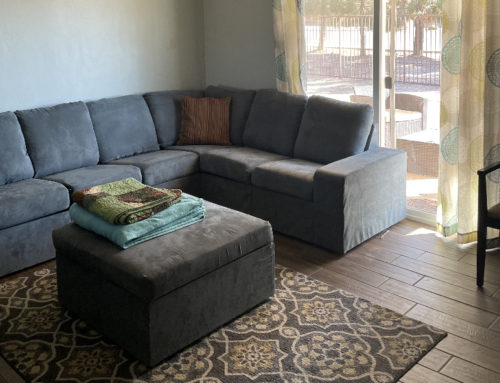Can your mobile phone replace your therapist?
After years of public speaking, I still find it terrifying. Recently, I was asked to speak to a group of Army Officers about dealing with pain under extreme circumstances. It was a big group and a serious topic. About a week before the event, I began to worry and that worry morphed into insomnia.
After several nights without sleep, a friend noticed my puffy eyes and asked how I was doing. “I’m nervous about a speech I’m giving to the Army,” I said. “Can’t sleep.”
“The whole Army?” he quipped, grinning. “I’d be nervous too.”
“No. Not the whole Army,” I answered, humorlessly.”If I can just get some sleep I think I’ll be fine.”
“You know,” he said, “they make an app for that.”
***
As a relationship-oriented mental-health professional, I’m suspicious of tech-based approaches to therapy. But that night I slipped under my covers, put my head to the pillow, inserted my earphones, and pushed the play button on my cell phone screen.
“Hello. I’m Byson Brown”, a British man said in a deep, floating monotone. “Please make sure you’re in a comfortable place where you won’t be disturbed for the next thirty minutes as I take you down into a deep state of physical and emotional relaxation.” I remember giggling at the ridiculous way he drew out the word “relaxaaaaation.” But I don’t remember anything after that except waking up to my cell phone beeping on my chest as the sun streamed through the shutters. I’d slept the whole night.
I continued to use the sleep-hypnosis app for the next several days and delivered my speech, greatly afraid, but well rested. It went well. There was applause and even some laughter, and the officers thanked me for a “great speech” afterwards.
***
Since then I’ve downloaded and tested other apps designed to assess or improve emotional functioning, intrigued by the idea that a smart phone might actually be smart enough to serve as an effective therapeutic tool for my clients.
After all, it had worked for me.
What I’ve found in my research is a huge array of apps designed to complement, and in some cases even replace, traditional human-based therapy. Do they work? My own tentative conclusion is that yes, these apps can be effective tools; sometimes, for some people, in certain situations, and usually in conjunction with human-to-human therapy.
Some apps have been designed by universities, licensed clinicians, and certified hypnotherapists, while other apps have less impressive, or at least less transparent, pedigrees. Just like their human counterparts, there seems to be wide variation in the quality of “pocket therapists.”
So choose with care.
***
If you are a client or clinician interested in the possibility of using mobile technology as a mental health or treatment tool, the following tips might help you navigate the burgeoning pocket-therapy industry.
Read the Reviews: User reviews offer great insight into an app’s perceived efficacy and may provide clues about why it’s working well for some and not for others. Look for apps with enough reviews to give you confidence that it’s an established tool and that the reviews are written by real users, not just friends of the developers.
When in Doubt, Try it Out: Especially if you have a trusted therapist to help monitor the results over time, give interesting apps a try. They are cheap and it generally requires only a little time to know whether the app is or is not going to work for you. Your honest review of the product (positive or negative) will help other consumers understand whether this app might or might not be for them.
Log your Experience: Keep a daily log of how you’re using the app and whether or not it seems to be helping. If you sense that the app is actually making you feel worse (especially with serious issues like clinical depression, PTSD, and debilitating anxiety) stop using it immediately and debrief with your therapist.
Research the Developers: Look for a development team that includes credible and experienced clinicians. What other apps have these developers been involved with and are those apps oriented toward mental health? Avoid apps created by clinical amateurs.
Understand the Purpose: Get very specific in your understanding of what the app is concretely promising and compare that to what you’re seeking. Some apps are diagnostic, some are for in-the-moment symptom reduction (e.g. when you feel a panic attack coming on in specific situations), some are for prevention, and some are designed to address core issues. If you get a program designed to diagnose anxiety, but you already know you’re anxious and really need symptom reduction, you’ll be disappointed.
Understand the Approach: How the app attempts to address the issue at hand should be clear in the app’s descriptive materials. What is the theoretical orientation of the developers and what treatment modalities are they designing their tool around, family systems? E.M.P.O.W.E.R? Cognitive behavioral? DBT? SMART recovery? Exposure therapy? Biofeedback? Be sure that this is clearly articulated and that the approach makes intuitive sense, and clinical sense, if you’re a mental-health professional or savvy mental-health consumer.
Don’t Fire your Therapist Yet: Part of a therapist’s job is to serve as an objective third party to monitor progress, lack of progress, regression, and risk factors. A therapist can also help you review the objectives and approaches used in a given app to help you make sound purchasing and usage decisions. Finally, no app can replace the interactive dynamic of a human clinician. Relationship is fundamentally what therapy is about; an app can complement, but not replace a trust-based therapeutic relationship with another person.
***
My own impression is that these apps make the most sense for use by high-functioning individuals who are deeply engaged in their own treatment decisions. Apps that offer a clear and circumscribed function (e.g. help you sleep, reduce panic symptoms in the moment, implement DBT routines, etc.) and that are designed by clinicians as a complement, not replacement, to therapy seem to have the most promise as therapeutic tools.
Regardless of impressive advances in technology-based therapies, my own policy is to proceed with curiosity, and caution. For now, the only therapist I’ll stick in my own pocket is one who promises little things. Like some help falling asleep.




